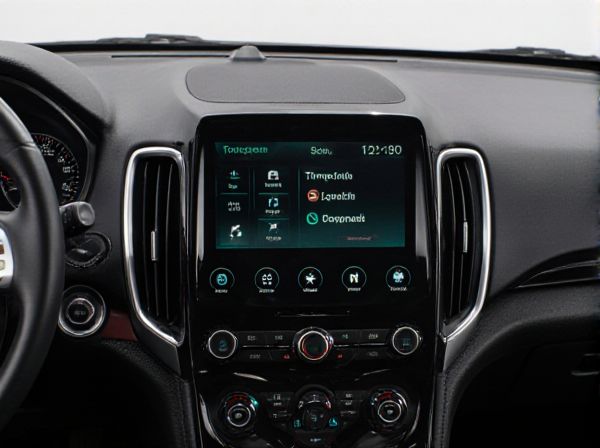
Photo illustration: Capacitive Touchscreen vs Resistive Touchscreen
Capacitive touchscreens offer higher sensitivity and multi-touch capabilities, making them ideal for smartphones and tablets. Resistive touchscreens can be operated with any object, including a stylus or gloved finger, providing versatility in industrial or rugged environments. Your choice depends on whether you prioritize responsiveness or compatibility with different input methods.
Table of Comparison
| Feature | Capacitive Touchscreen | Resistive Touchscreen |
|---|---|---|
| Touch Sensitivity | High sensitivity, supports multi-touch | Lower sensitivity, single-touch only |
| Durability | More durable, scratch resistant glass | Prone to wear, sensitive to pressure |
| Visibility | Clearer display, better outdoor readability | Lower clarity, affected by sunlight |
| Cost | Generally more expensive | More affordable |
| Usage | Finger touch, gestures supported | Stylus or finger press required |
| Response Time | Faster response | Slower response |
Introduction to Touchscreen Technologies
Capacitive touchscreen technology relies on the electrical properties of the human body to detect touch, offering high sensitivity and multi-touch support, commonly used in smartphones and tablets. Resistive touchscreen technology consists of multiple layers separated by a gap, detecting touch through pressure, making it suitable for stylus input and use in harsh environments where gloves or objects are involved. The fundamental difference lies in input detection methods, with capacitive screens requiring conductive touch and resistive screens responding to mechanical pressure.
What is a Capacitive Touchscreen?
A capacitive touchscreen operates by detecting changes in the electrical field caused by the conductive properties of a human finger, enabling fast and accurate multi-touch input. Unlike resistive touchscreens, which rely on pressure applied to flexible layers, capacitive screens feature a glass panel coated with an indium tin oxide layer that senses touch through capacitive coupling. This technology offers higher durability, better clarity, and responsiveness, making it ideal for smartphones, tablets, and modern interactive displays.
What is a Resistive Touchscreen?
A resistive touchscreen consists of two flexible layers separated by a small gap that registers touch when pressure causes the layers to make contact. It is highly accurate and works with any input, including fingers, stylus, or gloved hands, making it ideal for industrial and medical applications. Resistive screens typically offer lower brightness and less durability compared to capacitive touchscreens but excel in environments requiring high touch precision.
How Capacitive Touchscreens Work
Capacitive touchscreens operate by detecting the electrical properties of the human body, utilizing a layer of capacitive material that stores electrical charge. When a finger touches the screen, it alters the local electrostatic field and changes the capacitance, which sensors then register to determine the precise touch location. This technology offers higher sensitivity and multi-touch capability compared to resistive touchscreens, which rely on pressure applied to multiple layers.
How Resistive Touchscreens Work
Resistive touchscreens function by layering two electrically conductive sheets separated by a small gap; when pressure is applied, the layers touch, creating a change in electrical current that is detected as input. This technology allows for precise touch recognition using any object, including fingers, styluses, or gloves, making it versatile in various environments. Resistive screens are cost-effective and durable but typically offer lower clarity and multitouch capability compared to capacitive touchscreens.
Key Differences Between Capacitive and Resistive Touchscreens
Capacitive touchscreens detect touch through the electrical conductivity of the human finger, offering higher sensitivity and multi-touch support, while resistive touchscreens rely on pressure applied to two flexible layers, making them more versatile for use with gloves or styluses. Capacitive screens provide brighter displays and better durability but are generally more expensive and less effective in wet conditions compared to resistive screens. Resistive touchscreens excel in cost-effectiveness and precise input but lack the advanced gesture recognition and responsiveness found in capacitive technology.
Advantages of Capacitive Touchscreens
Capacitive touchscreens offer superior touch sensitivity and multi-touch support, enabling more precise and responsive user interactions compared to resistive screens. They provide higher clarity and brightness, enhancing display quality by allowing more light to pass through the screen layers. These touchscreens also boast greater durability and resistance to scratches, making them ideal for modern smartphones, tablets, and interactive displays.
Advantages of Resistive Touchscreens
Resistive touchscreens offer superior accuracy and responsiveness by detecting pressure from any input device, including styluses or gloved fingers, making them ideal for industrial and medical applications. They provide better durability in harsh environments due to their rigid screen construction and resistance to dirt, water, and contaminants. Cost-effectiveness and simplicity in technology contribute to lower manufacturing and replacement expenses compared to capacitive touchscreens.
Common Applications for Each Touchscreen Type
Capacitive touchscreens are commonly used in smartphones, tablets, and interactive kiosks due to their high sensitivity, multi-touch capability, and durability. Resistive touchscreens find frequent application in industrial equipment, point-of-sale (POS) systems, and medical devices where precision input with styluses or gloved hands is essential. The choice between capacitive and resistive screens depends on user interaction needs, environmental conditions, and device design priorities.
Choosing the Right Touchscreen Technology for Your Needs
Capacitive touchscreens offer higher sensitivity and multi-touch capabilities, making them ideal for smartphones and tablets where precision and gesture control are essential. Resistive touchscreens provide better durability and work well with styluses or gloves, suitable for industrial applications and environments with exposure to dirt or moisture. Choosing the right touchscreen depends on factors like user interface complexity, environmental conditions, and budget constraints.
 caratoz.com
caratoz.com